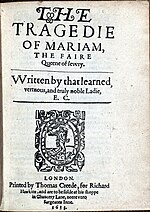Thomas Creede
Thomas Creede ( fl. 1593-1617) was an English printer of the late 16th and early 17th centuries. He was considered one of the best of his time. He ran his business in London at The Wheel of St Catherine on Thames Street from 1593 to 1600. After that, his business was in the Eagle and Child House in Old Exchange from 1600 to 1617. Creede is known for its Printing of works of the English Renaissance drama, in particular for ten editions of six works by Shakespeare and three so-called Shakespeare apocrypha.
Printing units
In Creede's time, printers were rarely also publishers. The editorship lay with the stationers or with booksellers who commissioned specialized workshops with the print jobs. There were also exceptions, such as William Jaggard , who regularly appeared as editor and printer at the same time. An important part of Creedes work concerned Shakespeare's texts, whereby he was usually only active as a printer, which was commissioned by editors. In some cases, Creede also acted as editor.
- Shakespeare
For the bookseller Thomas Millington Creede printed:
- Henry VI, Part 2 , Q1 1594 ("bad quarto")
For Andrew Wise :
- Richard III , Q2, 1598
- Richard III, Q3, 1602
For Matthew Law (who acquired the rights to Richard III from Wise in 1603):
- Richard III, Q4, 1605
- Richard III, Q5, 1612
For Cuthbert Burby :
- Romeo and Juliet , Q2, 1599
For Thomas Millington and John Busby:
- Henry V , Q1, 1600 ("bad quarto")
For Thomas Pavier (who acquired the rights to Henry V around 1600):
- Henry V, Q2, 1602 ("bad quarto")
For Arthur Johnson:
- The Merry Wives of Windsor , Q1, 1602 ("bad quarto")
For Henry Gosson, Creede printed with William White:
- Pericles, Prince of Tire , Q1, 1609
For Nathaniel Butter :
- The London Prodigal , Q, 1605 (one of the "Shakespeare Apocrypha")
For Arthur Johnson:
- The Merry Devil of Edmonton , Q2, 1612 ("Shakespeare Apocrypha")
- Other Elizabethan authors
Creede was also responsible for printing numerous other dramatic texts. For Richard Hawkins, Creede printed the drama The Tragedy of Mariam by Elizabeth Tanfield Cary in 1613 . It is the first tragedy written by a woman to be printed in England. For Richard Olive, Creede printed the second edition of a pamphlet by Robert Greene from 1592 Greene's Groats-Worth of Wit in 1596 . This contains the earliest mention of Shakespeare as an author.
Editing
In some cases, Creede acted as editor similar to Valentine Simmes . Noteworthy is the editing of 10 dramas during the early stages of his business.
- A Looking Glass for London and England , Q1, 1594; Q2, 1598 (Entry in the Stationers' Register on March 5, 1594.)
- Selimus, 1594 (no entry in the Stationers' Register)
- The Pedlar's Prophecy, 1595 (registered May 13, 1594)
- The Famous Victories of Henry V, 1598 (registered May 14, 1594)
- The Scottish History of James IV, 1598 (registered May 14, 1594)
- Menaechmi , 1595 (registered June 10, 1594)
- The True Tragedy of Richard III , 1594 (registered June 19, 1594)
- Locrine , 1595 (registered July 20, 1594)
- Alphonsus King of Aragon, 1599 (not in the Stationers' Register)
- Sir Clyomon and Sir Clamydes , 1599 (not in the Stationers' Register).
Locrine is another work from the "Shakespeare Apocrypha" series. The anonymously published work Famous Victories of Henry V is considered to be the source for Shakespeare's drama. It is noteworthy that Creede's attributions of authorship for works for which he was responsible as editor are all correct. Creede also published non-dramatic works such as in 1597 the third edition of the English translation of Thomas More's Utopia, first published in 1551 by the humanist Ralph Robinson .
obituary
While Creede's skills as a printer are beyond question, his activities in connection with the bad quartos and falsely attributed works (so-called "Shakespeare Apocrypha") have led scholars to question his moral integrity. The stationer's records show that Creede had to pay fines twice for violating guild rules in 1595. In 1608 he was prosecuted by the London court for "fornication". The married Creede was charged with having sex with a 25-year-old maid who became pregnant by him. In 1616 Creede entered into a business partnership with Bernard Alsop, who took over his business in 1617.
Individual evidence
- ^ Halliday, p. 120.
- ^ This text is an early version with the title: The First Part of the Contention Betwixt the Two Famous Houses of York and Lancaster. Compared to the folio version, this is a so-called " bad quarto ". Millington published The Contention's Q2 in 1600 , printed by Valentine Simmes .
- ↑ Blayney, pp. 437-442.
- ^ Dobson Oxford Companion. Article Robert Greene , p. 173.
- ^ Maxwell, p. 197.
- ↑ Maxwell, pp. 19-21.
- ↑ Gowing and Crawford, pp. 142-146.
literature
- Blayney, Peter: The prevalence of shared printing in the early seventeenth century. In: Papers of the Bibliographic Society of America. Volume 67, 1973, pp. 437-442.
- Chambers, EK : The Elizabethan Stage. 4 volumes, Clarendon Press, Oxford 1923.
- Gowing, Laura, and Patricia M. Crawford. Women's Worlds in Seventeenth-Century England. London, Routledge, 2000. ISBN 978-0415156387
- Halliday, FE: A Shakespeare Companion 1564-1964. Penguin, Baltimore 1964.
- Baldwin Maxwell: Studies in the Shakespeare Apocrypha. King's Crown Press, New York 1956; Reprint: Greenwood Press, New York 1969, ISBN 0-8371-1857-3
- Pinciss, GM: Thomas Creede and the Repertory of the Queen's Men, 1583-1592. In: Modern Philology. Volume 67, 1970, pp. 321-330.
- Akihiro Yamada: Thomas Creede: Printer to Shakespeare and His Contemporaries. Meisei University Press, Tokyo 1994.
| personal data | |
|---|---|
| SURNAME | Creede, Thomas |
| BRIEF DESCRIPTION | English printer |
| DATE OF BIRTH | before 1593 |
| DATE OF DEATH | after 1617 |
